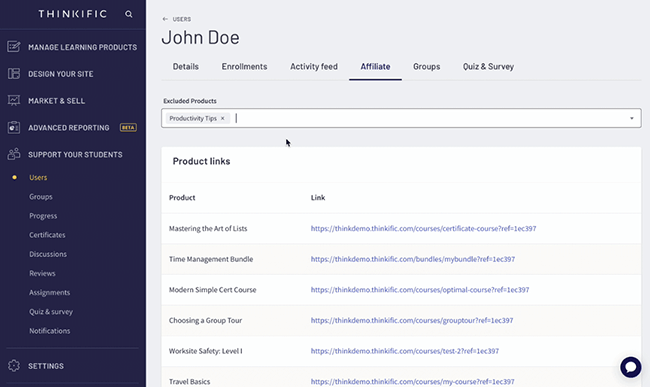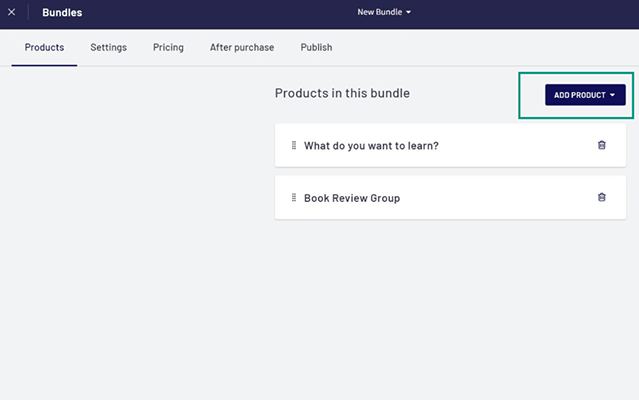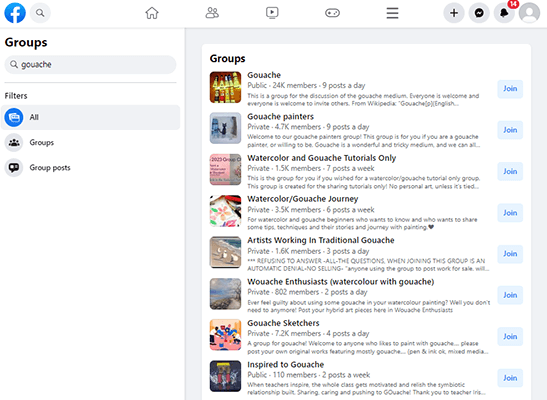How To Market An Online Course: 19 Proven Tactics

Are you just about done with creating your course and need more info on how to market online courses?
In this post, you’ll find over a dozen ways to market online courses.
But in order for these strategies to be effective, you need to have a few components set in place first:
- A well-defined target audience.
- An identifiable problem you can teach your audience to solve.
- A good title that’ll catch the attention of future students and intrigue them.
Once you have these components taken care of and your course is published, you’re ready to move on to the marketing phase.
How to market online courses with these 19 strategies
- Offer a free mini course.
- Create a social media challenge.
- Publish promotional content to multiple social media platforms.
- Launch an affiliate program.
- Add a link to your course sales page to your email signature.
- Offer course bundles.
- Collaborate with other creators in your niche.
- Self-publish a book on Amazon.
- Sponsor creators.
- Offer early access.
- Utilize email campaigns.
- Host a free webinar or live event.
- Start a Facebook group.
- Add multiple calls to action across your website.
- Make your course sales page easily accessible on your website.
- Purchase ads on multiple platforms.
- Go on a press tour and write a press release statement.
- Offer limited-time discounts.
- Get testimonials from popular creators in your niche.
1. Offer a free mini course
Your course content likely tackles a broad yet common problem in your niche by breaking it down into smaller problems that are easier for students to solve.
If you take one of these smaller issues and turn them into a much smaller course, you can offer that course for free and use it to market your premium course.
Sure, some students will complete the smaller course and be on their merry way.
Just be sure to make your mini course as engaging as your premium course.
You’ll light a fire under your mini course students and will encourage them to take the plunge and purchase your premium course to continue their education on the subject.
2. Create a social media challenge
A wildly underrated way to market your online course is by creating a social media challenge for it.

This can come in many shapes and sizes.
Let’s say you’re about to launch a course on how to paint landscapes with gouache-style paint.
Prior to launching your course, you could create a social media challenge in which you ask your followers to create their best original landscape gouache paintings and upload them to specific social media platforms.
A few prizes could be a complete gouache paint set for the first-place winner, free access to your course for the top five participants and a discount code for all other participants.

If you’re wondering what giveaway tool to use, SweepWidget is a great option as it offers over 90 different entry methods and integrates with over 30 platforms. It also has a free plan.
3. Publish promotional content to multiple social media platforms
The best part about social media is the way in which it cuts out the middleman as far as promotions go.
You can take matters into your own hands and promote your stuff yourself.
Hopefully, you’re familiar enough with your audience to know which platforms they spend the majority of their time on.
Learn the ins and outs of these platforms, and create social media posts and videos that are optimized for each as a way to promote your new online course.
Use social media scheduling tools like Sendible, SocialBee and Pallyy to plan out content in advance and stay on top of your promotional schedule.
4. Launch an affiliate program
Oh yes, affiliate programs aren’t just for retail stores, beauty brands and web applications.
Anyone can start an affiliate program, and most online course tools make it easy to create one.

Even if you use an LMS WordPress plugin, most of these plugins integrate with affiliate manager plugins.
An affiliate program incentivizes your students and fellow content creators to promote your course as they’ll earn commissions every time they refer new customers (students).
If your affiliate program does well enough, you’ll be able to rely on other marketing strategies a lot less as your affiliates will do the majority of your marketing for you.
10% is a fair commission rate to offer affiliates, but do what feels best to you.
5. Add a link to your course sales page to your email signature
This is a bit of a niche marketing strategy, but it’s an easy way to market online courses passively.
Add a simple link that leads to your course sales page to your email’s signature.
Hyperlink text that says “Learn about [course topic].”, “Having a problem with [course topic]?” or even as blunt as “Want to learn everything I know? Check out my course [course title]!”
Every reader or fellow creator will see this link when they email you.
6. Offer course bundles
A lot of online course creators don’t consider the way in which their pricing structure can be used as a subtle passive marketing strategy.
Most creators offer a single price or allow you to pay off the cost of the course in installments.
A pricing strategy many creators don’t consider is the course bundle.

There’s a reason why so many hosting and application companies offer three or more pricing plans.
When consumers are given more pricing options, they’re more likely to convert as one of those pricing options will seem like a great deal for them and a simple way for them to get what they want and still save.
When it comes to course bundles, you can offer multiple pricing options by offering multiple courses together or by offering extra study materials to students who are willing to pay more.
While few may opt for those higher pricing tiers, many more will be more likely to purchase the original pricing option you were going to offer as it’ll seem like a much bigger discount when compared to more expensive pricing options.
7. Collaborate with other creators
Collaboration is the key to successful creator businesses.
It mainly helps with getting your content in front of a larger audience, but you can also use this marketing tactic to launch a successful online course.
Think of or find creators in your niche who have the same or more followers/website visitors than you.
You might also consider collaborating with creators in complementary niches. For example, a creator who publishes fishing content may want to collaborate with a creator who publishes boat-related content.
Once you have a creator picked out, consider how you want to collaborate with them.
You can collaborate on a course and split the revenue, or you can offer to market something for them in exchange for them marketing your course for you.
8. Self-publish a book on Amazon
This is a marketing technique some creators, mainly bloggers, have been using for years to discreetly market their websites.
Amazon has a platform anyone can use to publish physical books and ebooks in a short amount of time.

What they’ll do is publish an ebook related to their niche, then insert a link to their website in the first few pages of that book.
You can do the same with your course.
Consider the mini course strategy again, only this time, create that content as an ebook instead.
Then, market and link to the premium version of your course in one of the first few pages of the book.
It’s subtle, and it may not net you very many students, but it’s still a great way to spread your influence to other platforms.
9. Sponsor creators
This is similar to affiliate marketing in that you pay creators to promote your course, except the process is entirely different.
When you sponsor creators, you pay them to create promotional content and upload it to their own platforms.
This could be a blog post, a social media message, a YouTube video or even an email sent to their email lists.
Your negotiations with said creators will likely include deciding on prices you both agree with as well what sort of content they should create.
It’d be best to simply ask the creator to look through the course’s content (which you’ll need to provide free access to) and give their audience their honest opinion of it.
You can always make the creator agree to letting you OK what they create before they send it out to the world.
No matter how you decide to go about this marketing strategy, it’ll be a powerful asset as it allows you to harness the power of another creator’s audience.
10. Offer early access
Early access, or pre-selling a course, is a pre-marketing tactic many course creators use as a way to test their course ideas and improve them as they create them.
Selling online courses for every idea you have is ill advised as you can’t guarantee your audience’s interest in the topic or whether or not your relationship with them has grown to the point where they’re willing to buy products from you.
Pre-selling removes these worries.
To offer early access, all you need to do is offer the unfinished version of your course for sale for a small fee, say $10-$25.
This huge discount is offered in exchange for your students’ patience and willingness to provide feedback as you complete the course.
The reason why many marketers use this as a way to test an audience’s desire for such a product is simple: if your audience isn’t willing to pay a small fee for your course idea, they aren’t going to pay top dollar for it, either.
However, if you do have a hit on your hands, you’ll have plenty of testimonials to use on your sales page well before you even launch.
11. Utilize email campaigns
This is another popular marketing strategy used by those who sell courses online.
These are drip email campaigns that work like this: you capture a lead for your online course.
Then, you nurture them by sending them short emails related to your course every few days. These emails are typically similar to the mini course idea, except this time, you create it as an email course instead.

The key word here is “related.”
Don’t mention your course during the nurture phase. Just send a new lesson to your lead every few days.
In the second to last email, tell your lead you have “an online course that covers this very topic” and that you’ll tell them more about it in the final email.
Then, market your course in that final email. You can even sweeten the deal by offering them a limited-time discount.
Of all the marketing strategies out there for online courses, this is one of the best to use to pre-qualify leads as being interested in your course topic.
12. Host a free webinar or live event
Here is yet another way you can use course content, or at least your course concept, as a way to market your course.
A webinar is an online seminar in which content creators host classes live.
These are typically premium events, but you can offer free webinars to attract more leads for your course.

Here’s what happens in a webinar: you livestream (typically video and audio) to your audience and present a lesson just as you would if you held classes in person.
When you use a webinar platform like Demio, you can share slides, screencast, host a Q&A session, run viewer polls and, most importantly, showcase special offers.
That last feature will enable you to market your course in the middle of your stream.
This is an effective course marketing strategy as it lets your audience experience what learning from you feels like.
If your webinar is a success, they’ll be more likely to purchase your course.
You can even repurpose your webinar later by uploading it to YouTube or uploading clips to TikTok, Instagram and Facebook.
13. Start a Facebook Group
Facebook is a popular platform many creators use for marketing online courses.
One particularly useful aspect about Facebook is the group feature included in the platform.
This feature lets anyone create a “group” where individuals can discuss a particular topic, interest or event.

Prior to launching your online course, create a Facebook group for your niche that heavily leans towards discussing topics related to your course.
That way, you can create multiple courses but use the same Facebook group to market each one.
Facebook groups are an underutilized marketing tactic. However, seeing as how Facebook is one of the web’s top three websites with billions of monthly active users, it’d be a shame to let its potential go to waste.
14. Add multiple CTAs across your entire website
Hopefully, you have a blog that generates a bit of traffic.
If so, you have a perfect way to market your online course: adding calls to action in key spots across your website.
These include a floating top bar that sticks to the top of your website as well as multiple CTAs on blog post pages.
Insert them somewhere in the content itself and in the sidebar (if you use one) on blog posts that heavily relate to your course’s topic.
Don’t discount the widget areas in your footer, either.
15. Make your course sales page easily accessible on your website
Along with obvious CTAs, you should make sure your course’s sales page is easily accessible to all users.
Create an item in your navigation menu called “Courses,” and add your course’s sales page as a sub item.
If you plan on growing your online course business well enough to offer multiple courses, create a dedicated page for the Courses top-level menu item.
This will give you a sort of a “hub” where your readers can see all of the courses you offer in one location.
Make sure this menu item is available in your footer as well.
This way if your reader misses the CTAs you insert on your website for one reason or another, they’ll still be able to access your course’s sales page.
16. Purchase ads on multiple platforms
This is a bit of an aggressive marketing tactic as you have to pay quite a bit of money for it upfront (depending on which platform you choose), and it’s much harder to ensure your course will be marketed to consumers who are most likely to purchase it.
Ad platforms have become quite sophisticated, in all fairness, so they often hit their mark when they attempt to market your course to your target audience.
However, they’re also very unpredictable given the way you have no control over the ways in which your ads get showcased on websites.
If you want more control over this, skip the Google ads and opt for Facebook ads and YouTube ads instead.

Facebook ads are much cheaper and enable you to choose your target audience.
YouTube ads always showcase in the same spots, so you won’t need to worry about negatively impacting your reputation by unleashing a marketing campaign that could be misconstrued as spam.
17. Go on a press tour
This strategy is similar to another strategy we mentioned on this list. That is, collaborating with other creators.
When artists and actors release new music and movies, they often market them by appearing on talk shows, conducting radio interviews and attending fan conventions.
You can do the same on a smaller scale by appearing on podcasts, doing blog post interviews and appearing in your fellow creators’ content on social media.
You can even go on a guest blogging spree specifically as a way to market your new online course.
It’s a difficult strategy to set up as it relies on receiving a lot of “yeses” from your fellow creators, but it can be highly effective once you get the ball rolling.
You can even write a press release statement and distribute to news breakers from around your niche.
18. Offer discounts
Sometimes consumers are interested in a product but need a bit of encouragement in order to buy.
Discounts do just that.
By offering discounts to your leads, you increase the odds of them actually going through with purchasing your course, especially if you offer limited-time offers.
19. Get testimonials from popular creators in your niche
This is similar to sponsoring creators, except you don’t pay creators to create specialized posts.
Offer free copies to your fellow creators instead.
Once they’ve had a chance to look over it, ask them for their opinion of the product.
If they have a positive opinion, ask them to provide a testimonial.
These testimonials, along with the ones you collected from early-access students, will pull a lot of weight when leads browse the landing page you’ve created for your course.
Final thoughts
These strategies will give you a fantastic starting point for marketing online courses, but you shouldn’t stop there.
A successful online course business continues the marketing process beyond these campaigns so your next big course launches without a hitch.
The best way to do this is by increasing brand awareness across relevant social media channels, meaning the social media platforms your target audience actually uses.
Start with your own website. Create content that improves SEO and drives organic traffic to your website.
Consider guest blogging as a way to increase brand awareness.
You can still use it as a link building strategy as this will also improve SEO, but if you think of guest blogging as more of a way to get your brand mentioned on as many relevant blogs as possible, you’ll notice your traffic and rankings improve over time independently from your own content.
You can also attend events related to your niche and snatch up as many speaking and interview opportunities as you can.
Lastly, consider branching outside of your blog by creating dedicated content to popular video platforms, especially TikTok, YouTube and Facebook.
Instagram can be a useful platform for posting behind the scenes updates, but it’s not a great platform for users to discover content.
Once you work on increasing your brand’s reach, you’ll find it much easier to market online courses the second time around.
Related Reading:
Disclosure: Our content is reader-supported. If you click on certain links we may make a commission.
